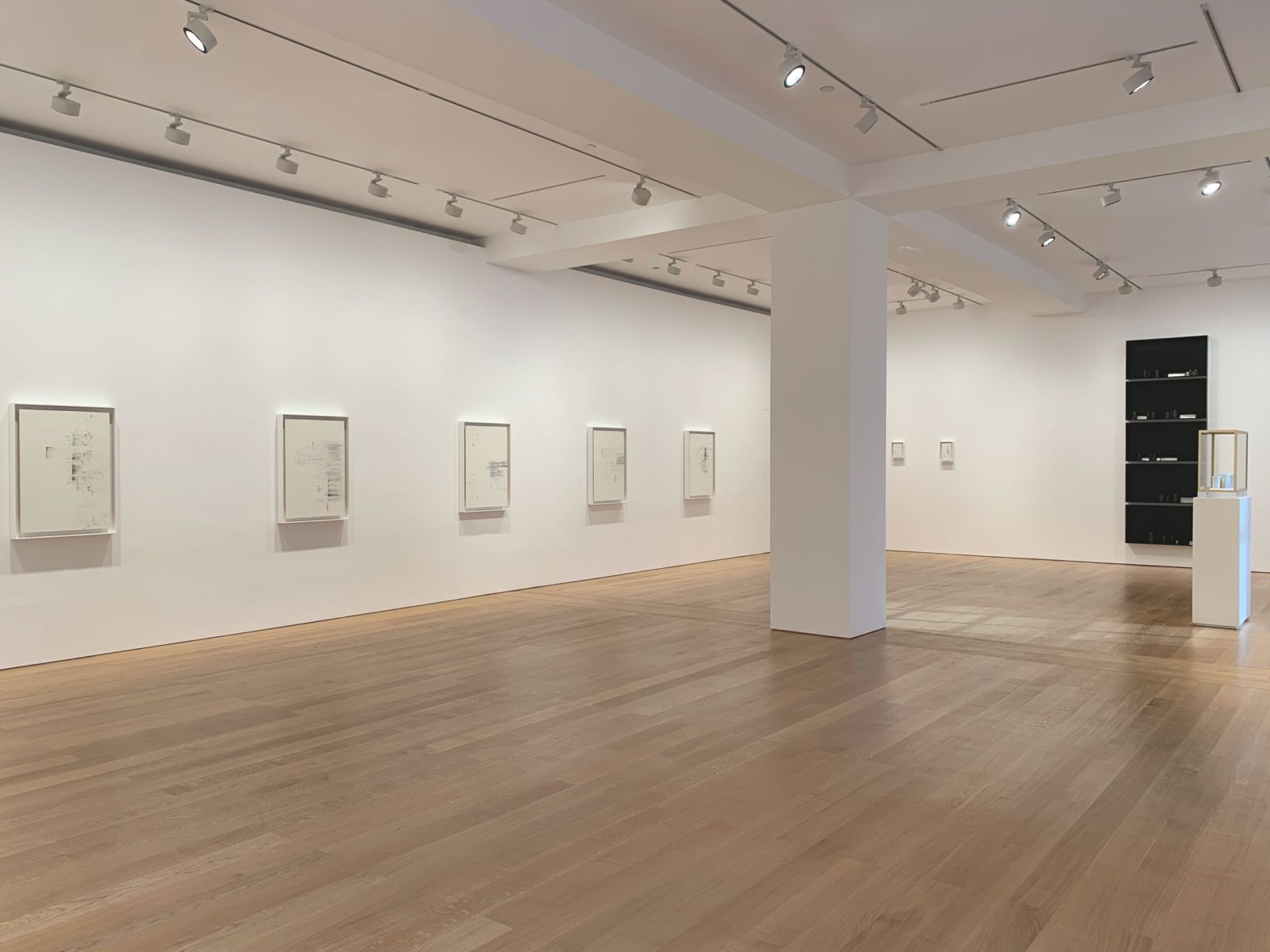
installation view2020
cold mountain clay
Gagosian, Hong Kong
20 November 2020 – 9 January 2021
Solitude is exacting. I read [the verses] out, wrote them, effaced them, worked on them, trying to find the amount of white space around a poem so that the words emerge... These works are my way of writing on a cave wall.
—Edmund de Waal
This exhibition takes its title from the famed Cold Mountain poems, a series of verses by the monk Hanshan, who, according to legend, lived as a recluse on the titular Chinese mountaintop during the Tang Dynasty (618–907 CE). Inspired by Hanshan’s practice of writing on rocks, tree trunks, and cave walls—thereby letting the elements erode his verses—de Waal’s new works are made through a cycle of inscription and effacement. He begins by coating a wood panel in liquid kaolin; while the slip is still wet, he floats flecks of gold leaf and writes lines of Hanshan’s poetry in graphite, oil stick, and charcoal. He then brushes these marks with additional layers of kaolin slip, repeating the process multiple times to produce a “fugitive poem,” an ethereal palimpsest of text that emulates the haze of memory.
Photography: Stephen Head
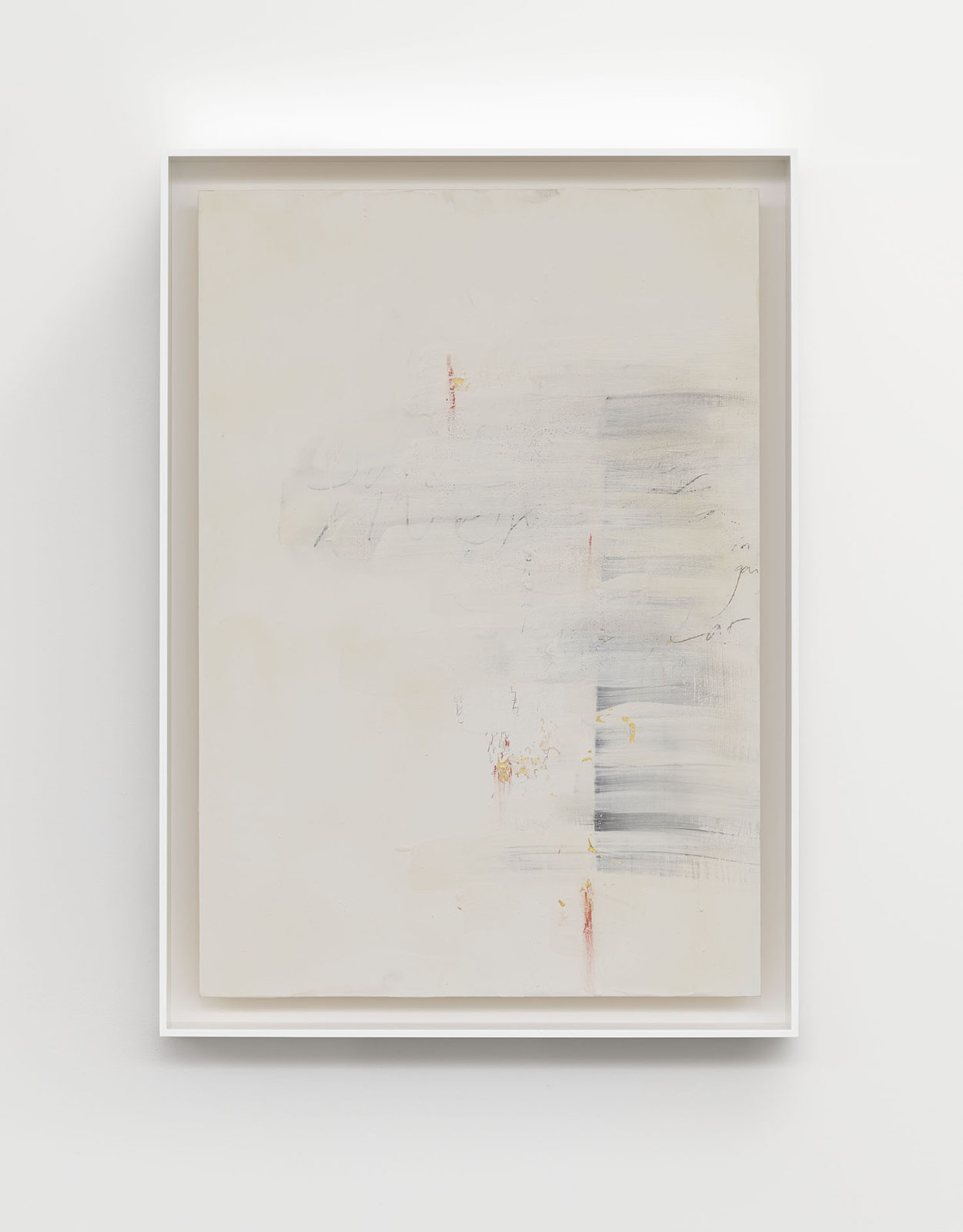
jade river2020
Ash panel with liquid kaolin, gold leaf, graphite, compressed charcoal and red oil stick in an open aluminium frame. Gilded on reverse.
92 × 66 × 7.5 cm
cold mountain clay
Gagosian, Hong Kong
20 November 2020 – 9 January 2021
Solitude is exacting. I read [the verses] out, wrote them, effaced them, worked on them, trying to find the amount of white space around a poem so that the words emerge... These works are my way of writing on a cave wall.
—Edmund de Waal
This exhibition takes its title from the famed Cold Mountain poems, a series of verses by the monk Hanshan, who, according to legend, lived as a recluse on the titular Chinese mountaintop during the Tang Dynasty (618–907 CE). Inspired by Hanshan’s practice of writing on rocks, tree trunks, and cave walls—thereby letting the elements erode his verses—de Waal’s new works are made through a cycle of inscription and effacement. He begins by coating a wood panel in liquid kaolin; while the slip is still wet, he floats flecks of gold leaf and writes lines of Hanshan’s poetry in graphite, oil stick, and charcoal. He then brushes these marks with additional layers of kaolin slip, repeating the process multiple times to produce a “fugitive poem,” an ethereal palimpsest of text that emulates the haze of memory.
Photography: Stephen Head
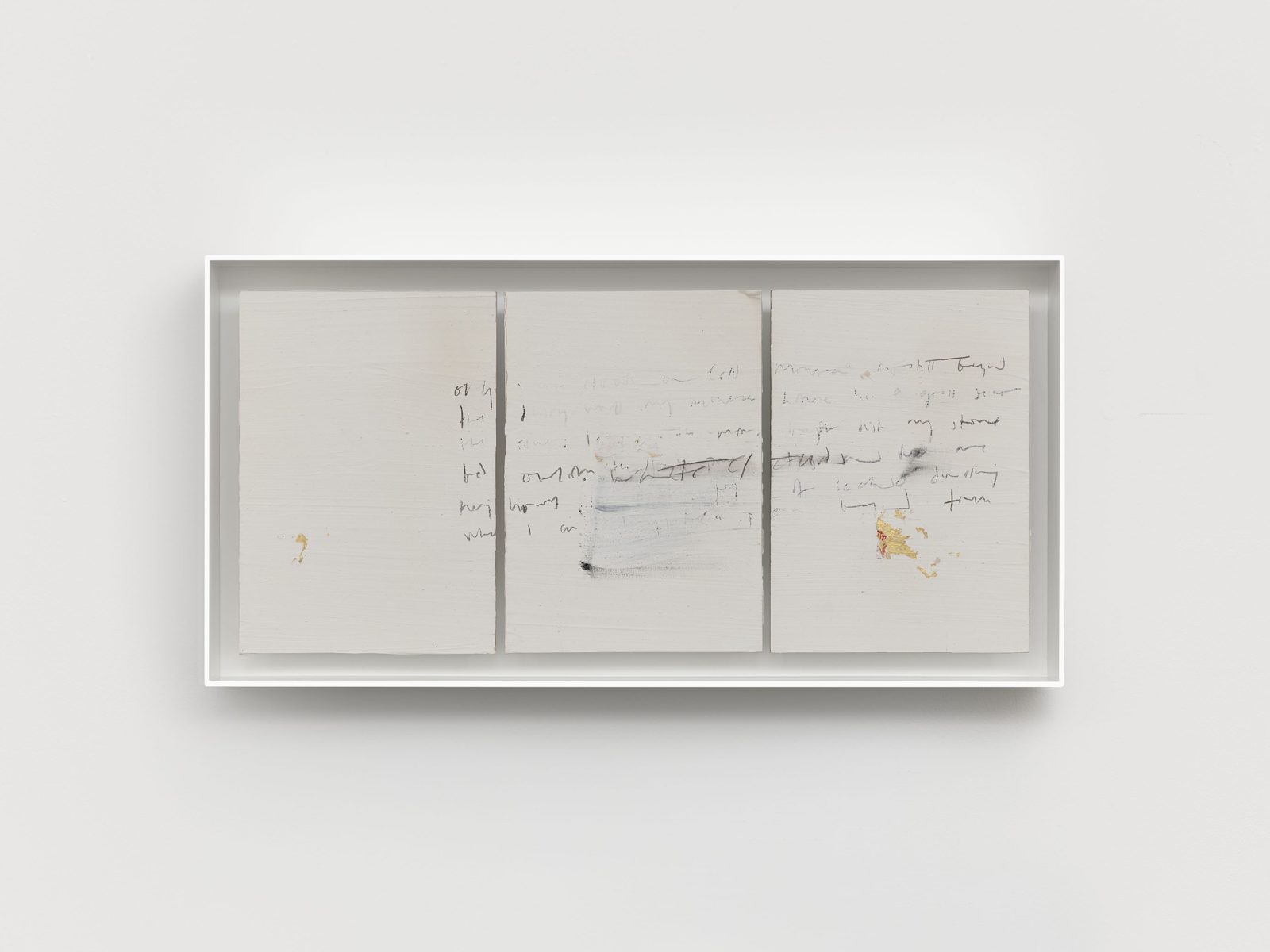
cold mountain, II2020
Triptych of oak and ash panels with liquid kaolin, gold leaf, graphite, compressed charcoal and red oil stick in an open aluminium frame. 2 x ash panels and 1 x oak panel. Gilded on reverse.
25 × 49 × 5 cm
cold mountain clay
Gagosian, Hong Kong
20 November 2020 – 9 January 2021
Solitude is exacting. I read [the verses] out, wrote them, effaced them, worked on them, trying to find the amount of white space around a poem so that the words emerge... These works are my way of writing on a cave wall.
—Edmund de Waal
This exhibition takes its title from the famed Cold Mountain poems, a series of verses by the monk Hanshan, who, according to legend, lived as a recluse on the titular Chinese mountaintop during the Tang Dynasty (618–907 CE). Inspired by Hanshan’s practice of writing on rocks, tree trunks, and cave walls—thereby letting the elements erode his verses—de Waal’s new works are made through a cycle of inscription and effacement. He begins by coating a wood panel in liquid kaolin; while the slip is still wet, he floats flecks of gold leaf and writes lines of Hanshan’s poetry in graphite, oil stick, and charcoal. He then brushes these marks with additional layers of kaolin slip, repeating the process multiple times to produce a “fugitive poem,” an ethereal palimpsest of text that emulates the haze of memory.
Photography: Stephen Head
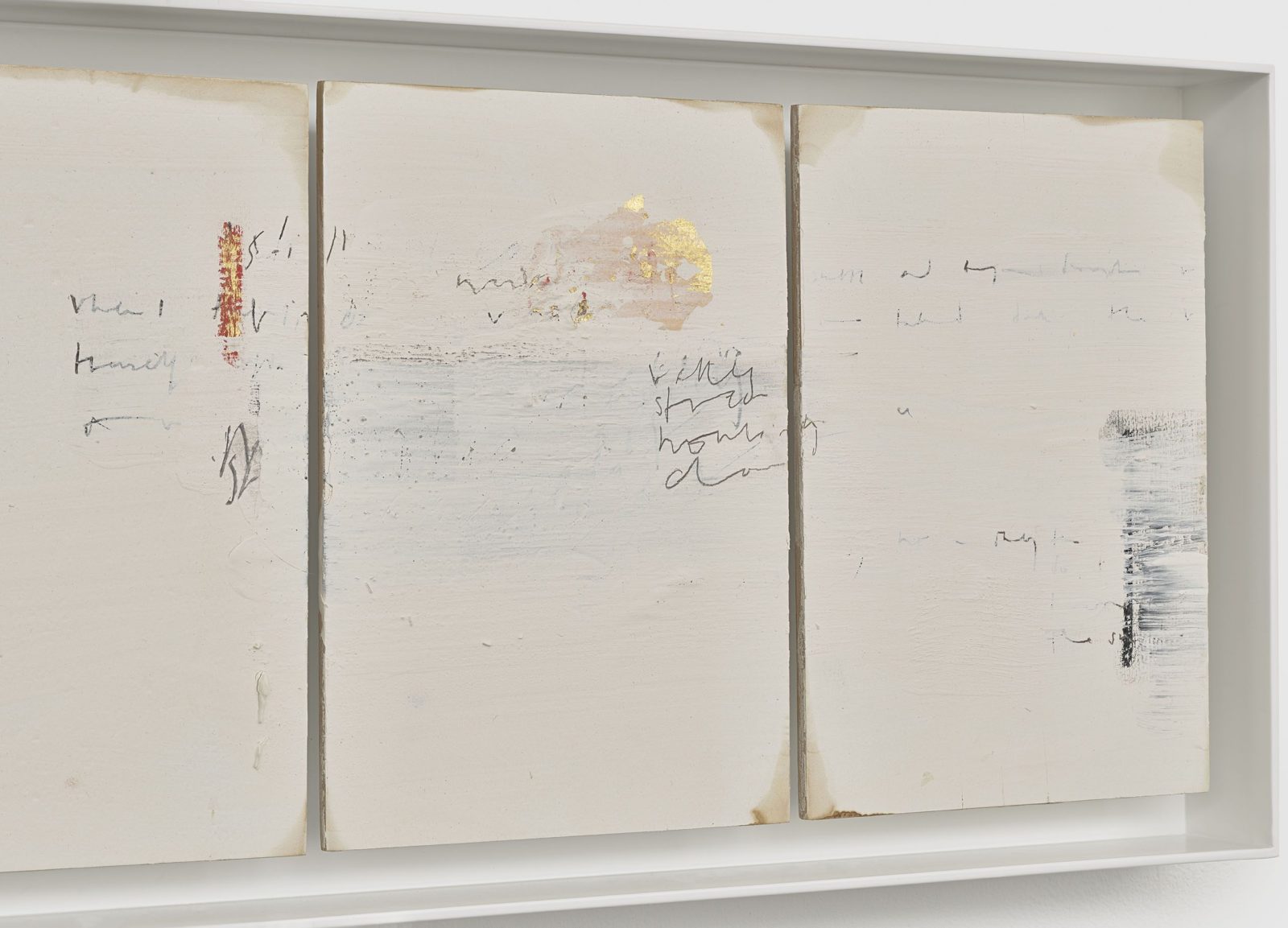
cold mountain, I (detail)2020
Triptych of oak and ash panels with liquid kaolin, gold leaf, graphite, compressed charcoal and red oil stick in an open aluminium frame. 2 x ash panels and 1 x oak panel.
25 × 49 × 5 cm
cold mountain clay
Gagosian, Hong Kong
20 November 2020 – 9 January 2021
Solitude is exacting. I read [the verses] out, wrote them, effaced them, worked on them, trying to find the amount of white space around a poem so that the words emerge... These works are my way of writing on a cave wall.
—Edmund de Waal
This exhibition takes its title from the famed Cold Mountain poems, a series of verses by the monk Hanshan, who, according to legend, lived as a recluse on the titular Chinese mountaintop during the Tang Dynasty (618–907 CE). Inspired by Hanshan’s practice of writing on rocks, tree trunks, and cave walls—thereby letting the elements erode his verses—de Waal’s new works are made through a cycle of inscription and effacement. He begins by coating a wood panel in liquid kaolin; while the slip is still wet, he floats flecks of gold leaf and writes lines of Hanshan’s poetry in graphite, oil stick, and charcoal. He then brushes these marks with additional layers of kaolin slip, repeating the process multiple times to produce a “fugitive poem,” an ethereal palimpsest of text that emulates the haze of memory.
Photography: Stephen Head
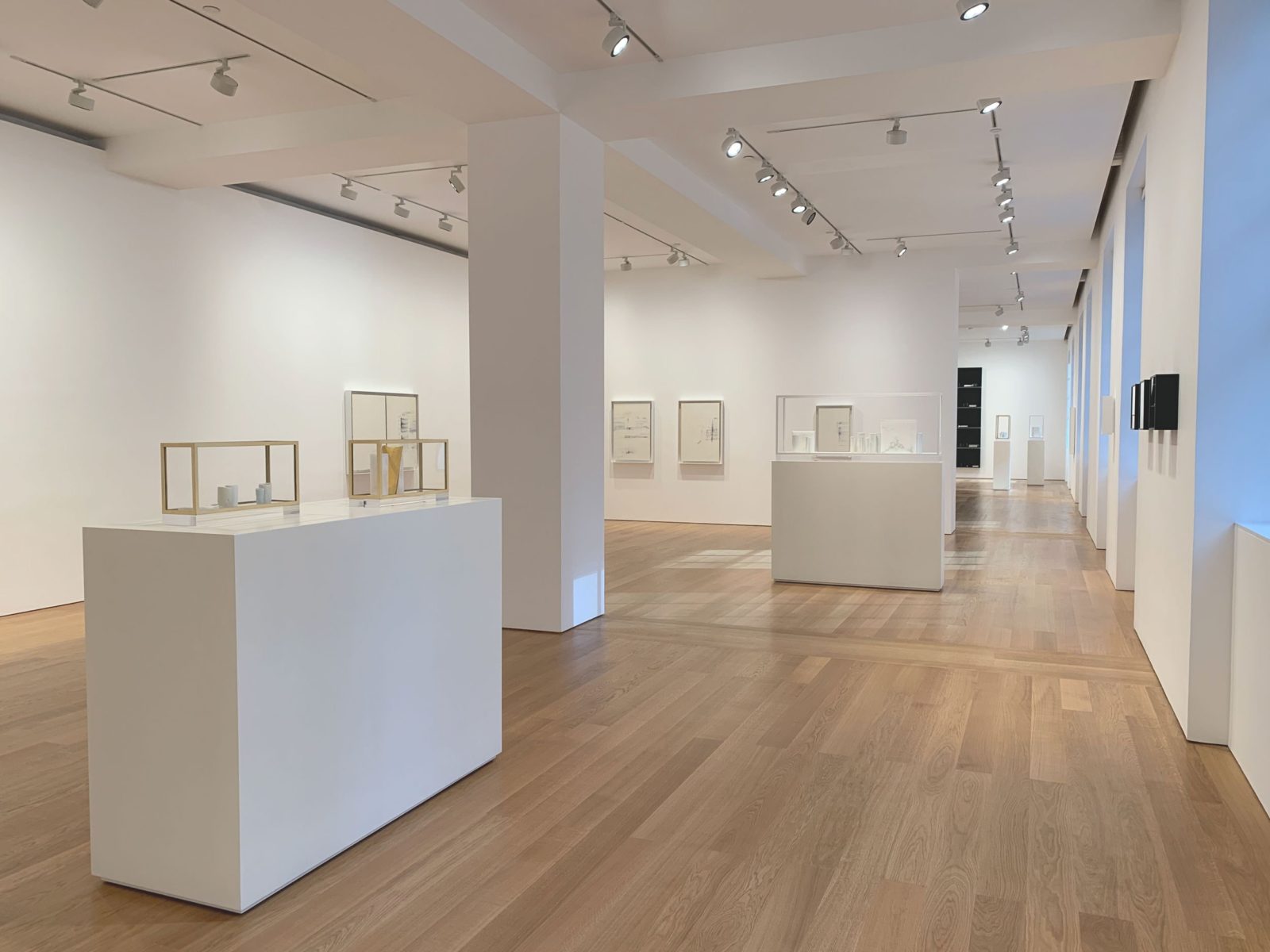
installation view2020
cold mountain clay
Gagosian, Hong Kong
20 November 2020 – 9 January 2021
Solitude is exacting. I read [the verses] out, wrote them, effaced them, worked on them, trying to find the amount of white space around a poem so that the words emerge... These works are my way of writing on a cave wall.
—Edmund de Waal
This exhibition takes its title from the famed Cold Mountain poems, a series of verses by the monk Hanshan, who, according to legend, lived as a recluse on the titular Chinese mountaintop during the Tang Dynasty (618–907 CE). Inspired by Hanshan’s practice of writing on rocks, tree trunks, and cave walls—thereby letting the elements erode his verses—de Waal’s new works are made through a cycle of inscription and effacement. He begins by coating a wood panel in liquid kaolin; while the slip is still wet, he floats flecks of gold leaf and writes lines of Hanshan’s poetry in graphite, oil stick, and charcoal. He then brushes these marks with additional layers of kaolin slip, repeating the process multiple times to produce a “fugitive poem,” an ethereal palimpsest of text that emulates the haze of memory.
Photography: Stephen Head
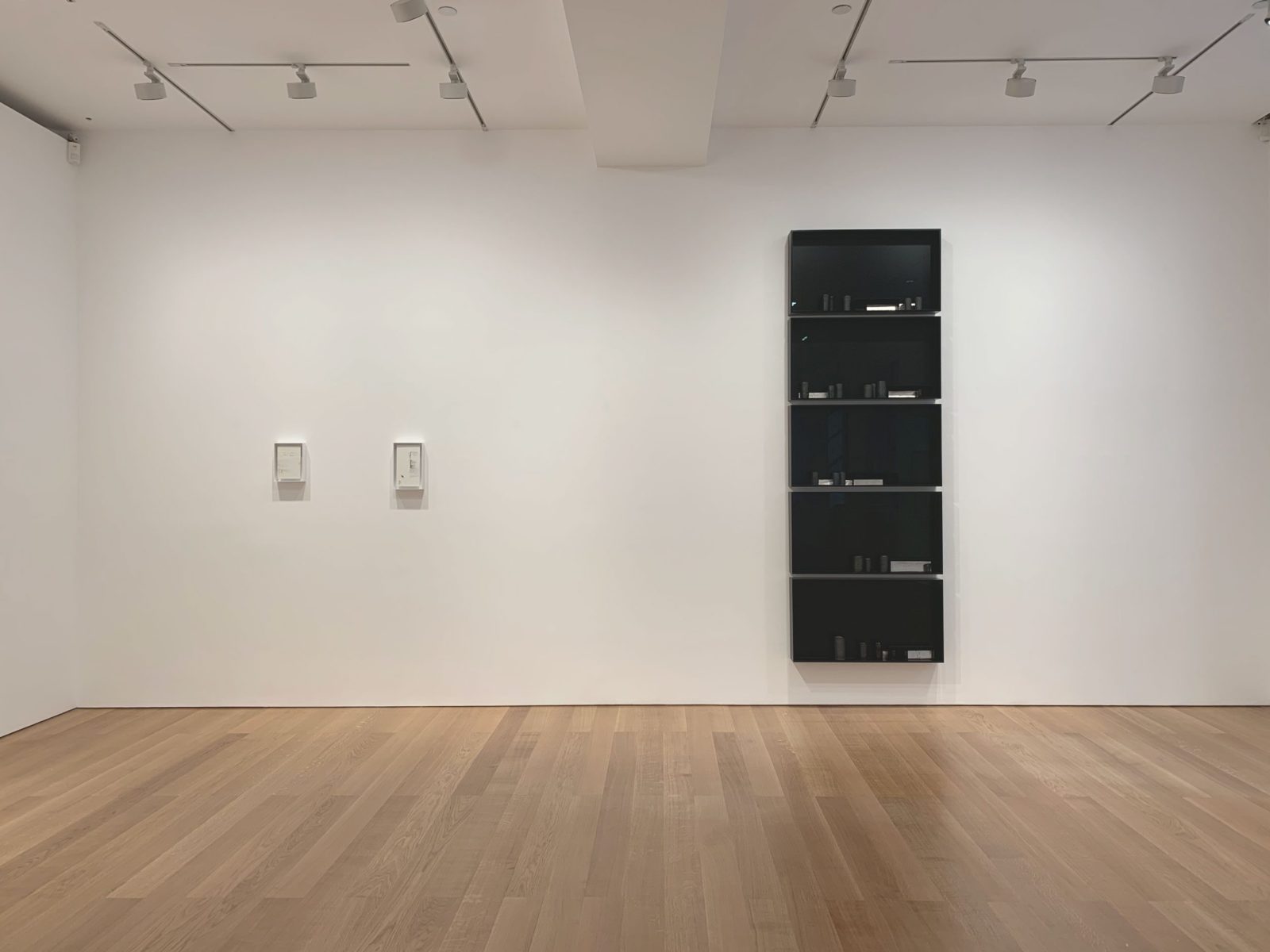
installation view2020
cold mountain clay
Gagosian, Hong Kong
20 November 2020 – 9 January 2021
Solitude is exacting. I read [the verses] out, wrote them, effaced them, worked on them, trying to find the amount of white space around a poem so that the words emerge... These works are my way of writing on a cave wall.
—Edmund de Waal
This exhibition takes its title from the famed Cold Mountain poems, a series of verses by the monk Hanshan, who, according to legend, lived as a recluse on the titular Chinese mountaintop during the Tang Dynasty (618–907 CE). Inspired by Hanshan’s practice of writing on rocks, tree trunks, and cave walls—thereby letting the elements erode his verses—de Waal’s new works are made through a cycle of inscription and effacement. He begins by coating a wood panel in liquid kaolin; while the slip is still wet, he floats flecks of gold leaf and writes lines of Hanshan’s poetry in graphite, oil stick, and charcoal. He then brushes these marks with additional layers of kaolin slip, repeating the process multiple times to produce a “fugitive poem,” an ethereal palimpsest of text that emulates the haze of memory.
Photography: Stephen Head
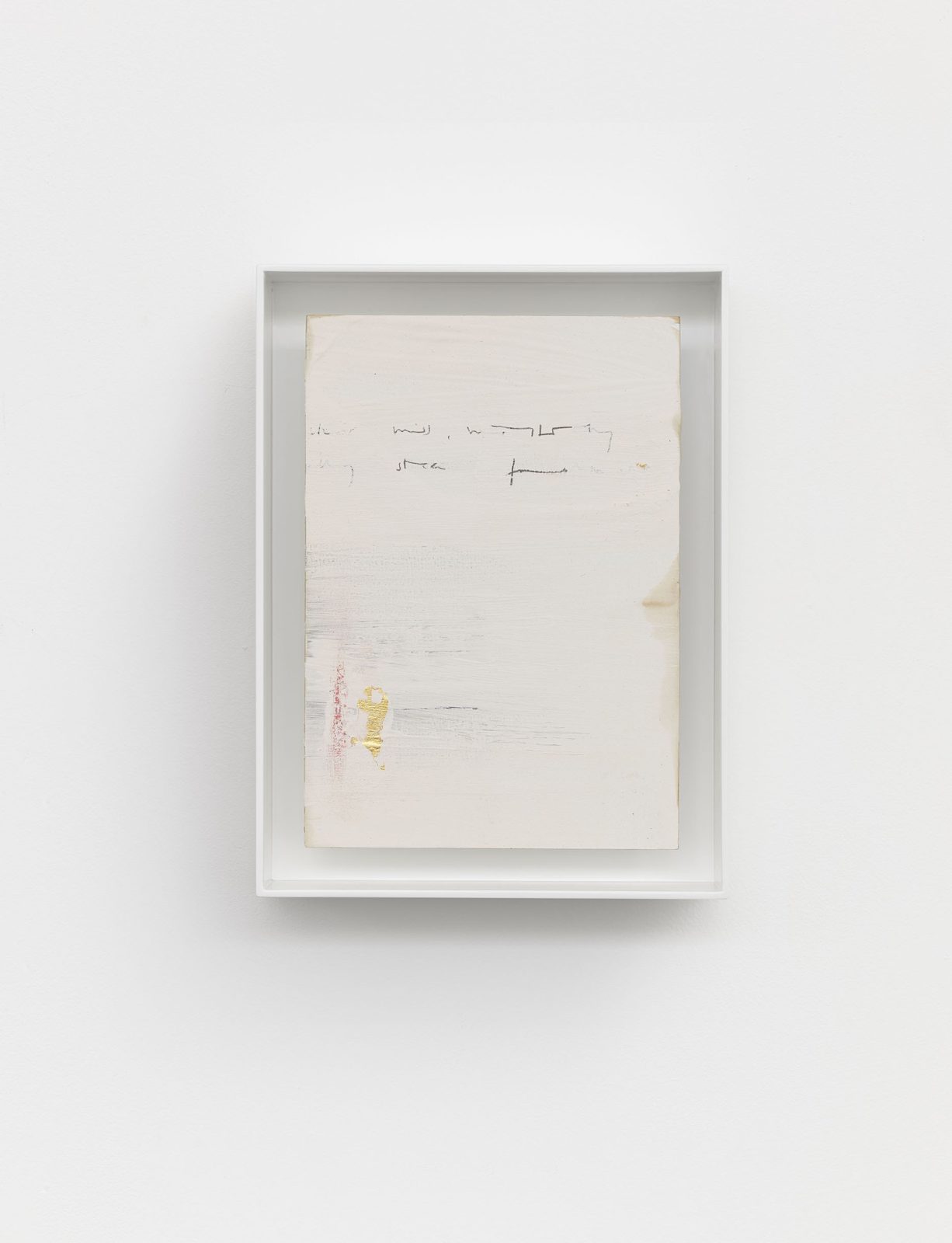
MMXX2020
Oak panel with liquid kaolin, gold leaf, graphite, compressed charcoal and red oil stick in an open aluminium frame. Gilded on reverse.
25 × 18.5 × 5 cm
cold mountain clay
Gagosian, Hong Kong
20 November 2020 – 9 January 2021
Solitude is exacting. I read [the verses] out, wrote them, effaced them, worked on them, trying to find the amount of white space around a poem so that the words emerge... These works are my way of writing on a cave wall.
—Edmund de Waal
This exhibition takes its title from the famed Cold Mountain poems, a series of verses by the monk Hanshan, who, according to legend, lived as a recluse on the titular Chinese mountaintop during the Tang Dynasty (618–907 CE). Inspired by Hanshan’s practice of writing on rocks, tree trunks, and cave walls—thereby letting the elements erode his verses—de Waal’s new works are made through a cycle of inscription and effacement. He begins by coating a wood panel in liquid kaolin; while the slip is still wet, he floats flecks of gold leaf and writes lines of Hanshan’s poetry in graphite, oil stick, and charcoal. He then brushes these marks with additional layers of kaolin slip, repeating the process multiple times to produce a “fugitive poem,” an ethereal palimpsest of text that emulates the haze of memory.
Photography: Stephen Head
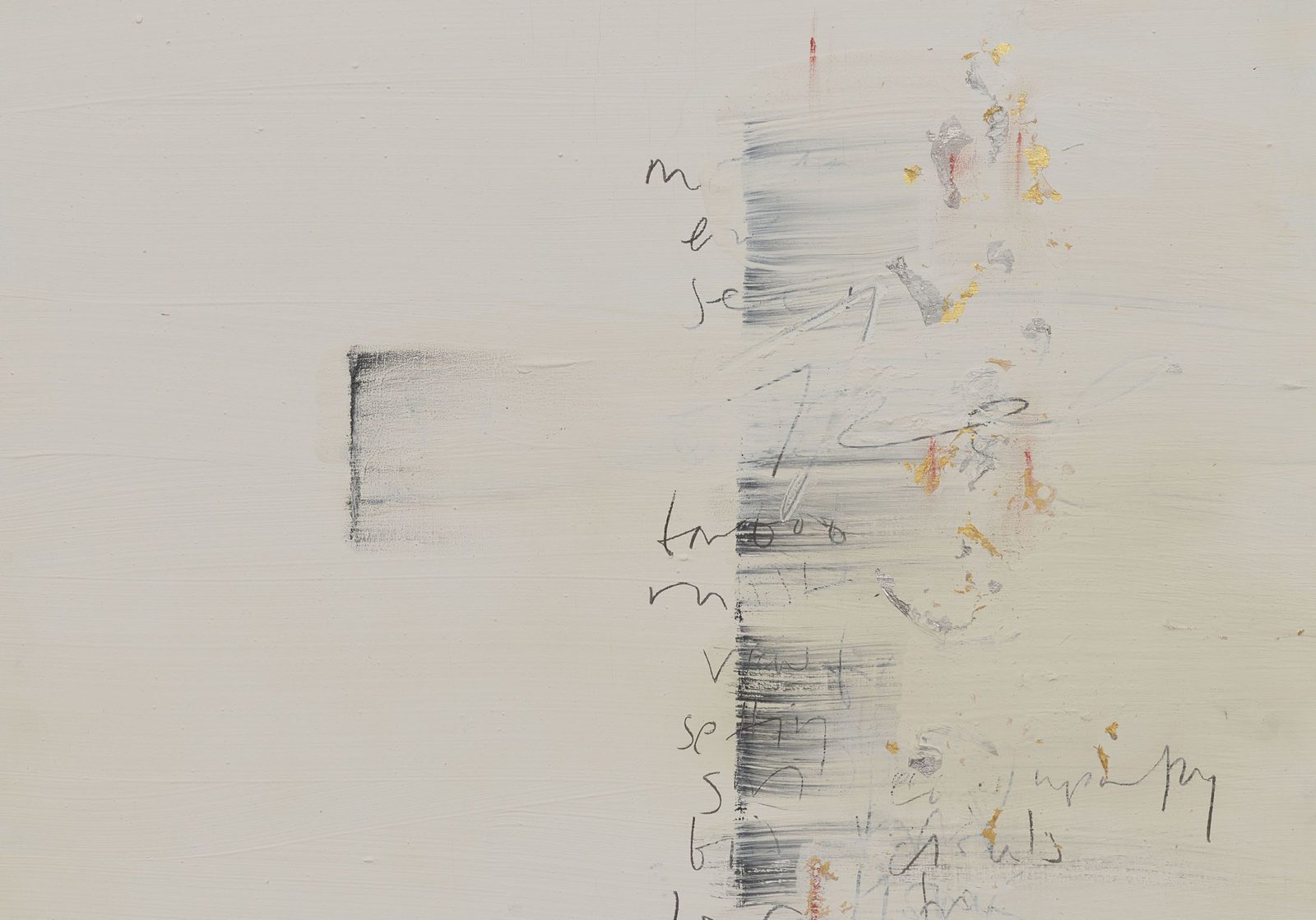
from miscellaneous poems of the mountains (detail)2020
Oak panel with liquid kaolin, gold and silver leaf, graphite, compressed charcoal and red oil stick in an open aluminium frame. NB: Gilded on reverse. Silver and gold leaf applied to surface. Gold leaf on reverse.
92 × 66 × 7.5 cm
cold mountain clay
Gagosian, Hong Kong
20 November 2020 – 9 January 2021
Solitude is exacting. I read [the verses] out, wrote them, effaced them, worked on them, trying to find the amount of white space around a poem so that the words emerge... These works are my way of writing on a cave wall.
—Edmund de Waal
This exhibition takes its title from the famed Cold Mountain poems, a series of verses by the monk Hanshan, who, according to legend, lived as a recluse on the titular Chinese mountaintop during the Tang Dynasty (618–907 CE). Inspired by Hanshan’s practice of writing on rocks, tree trunks, and cave walls—thereby letting the elements erode his verses—de Waal’s new works are made through a cycle of inscription and effacement. He begins by coating a wood panel in liquid kaolin; while the slip is still wet, he floats flecks of gold leaf and writes lines of Hanshan’s poetry in graphite, oil stick, and charcoal. He then brushes these marks with additional layers of kaolin slip, repeating the process multiple times to produce a “fugitive poem,” an ethereal palimpsest of text that emulates the haze of memory.
Photography: Stephen Head

installation view2020
cold mountain clay
Gagosian, Hong Kong
20 November 2020 – 9 January 2021
Solitude is exacting. I read [the verses] out, wrote them, effaced them, worked on them, trying to find the amount of white space around a poem so that the words emerge... These works are my way of writing on a cave wall.
—Edmund de Waal
This exhibition takes its title from the famed Cold Mountain poems, a series of verses by the monk Hanshan, who, according to legend, lived as a recluse on the titular Chinese mountaintop during the Tang Dynasty (618–907 CE). Inspired by Hanshan’s practice of writing on rocks, tree trunks, and cave walls—thereby letting the elements erode his verses—de Waal’s new works are made through a cycle of inscription and effacement. He begins by coating a wood panel in liquid kaolin; while the slip is still wet, he floats flecks of gold leaf and writes lines of Hanshan’s poetry in graphite, oil stick, and charcoal. He then brushes these marks with additional layers of kaolin slip, repeating the process multiple times to produce a “fugitive poem,” an ethereal palimpsest of text that emulates the haze of memory.
Photography: Stephen Head

poems from cold mountain, III2020
Ash panel with liquid kaolin, gold leaf, graphite and compressed charcoal in an open aluminium frame. Gilded on reverse.
67.5 × 49.5 × 7.5 cm
cold mountain clay
Gagosian, Hong Kong
20 November 2020 – 9 January 2021
Solitude is exacting. I read [the verses] out, wrote them, effaced them, worked on them, trying to find the amount of white space around a poem so that the words emerge... These works are my way of writing on a cave wall.
—Edmund de Waal
This exhibition takes its title from the famed Cold Mountain poems, a series of verses by the monk Hanshan, who, according to legend, lived as a recluse on the titular Chinese mountaintop during the Tang Dynasty (618–907 CE). Inspired by Hanshan’s practice of writing on rocks, tree trunks, and cave walls—thereby letting the elements erode his verses—de Waal’s new works are made through a cycle of inscription and effacement. He begins by coating a wood panel in liquid kaolin; while the slip is still wet, he floats flecks of gold leaf and writes lines of Hanshan’s poetry in graphite, oil stick, and charcoal. He then brushes these marks with additional layers of kaolin slip, repeating the process multiple times to produce a “fugitive poem,” an ethereal palimpsest of text that emulates the haze of memory.
Photography: Stephen Head
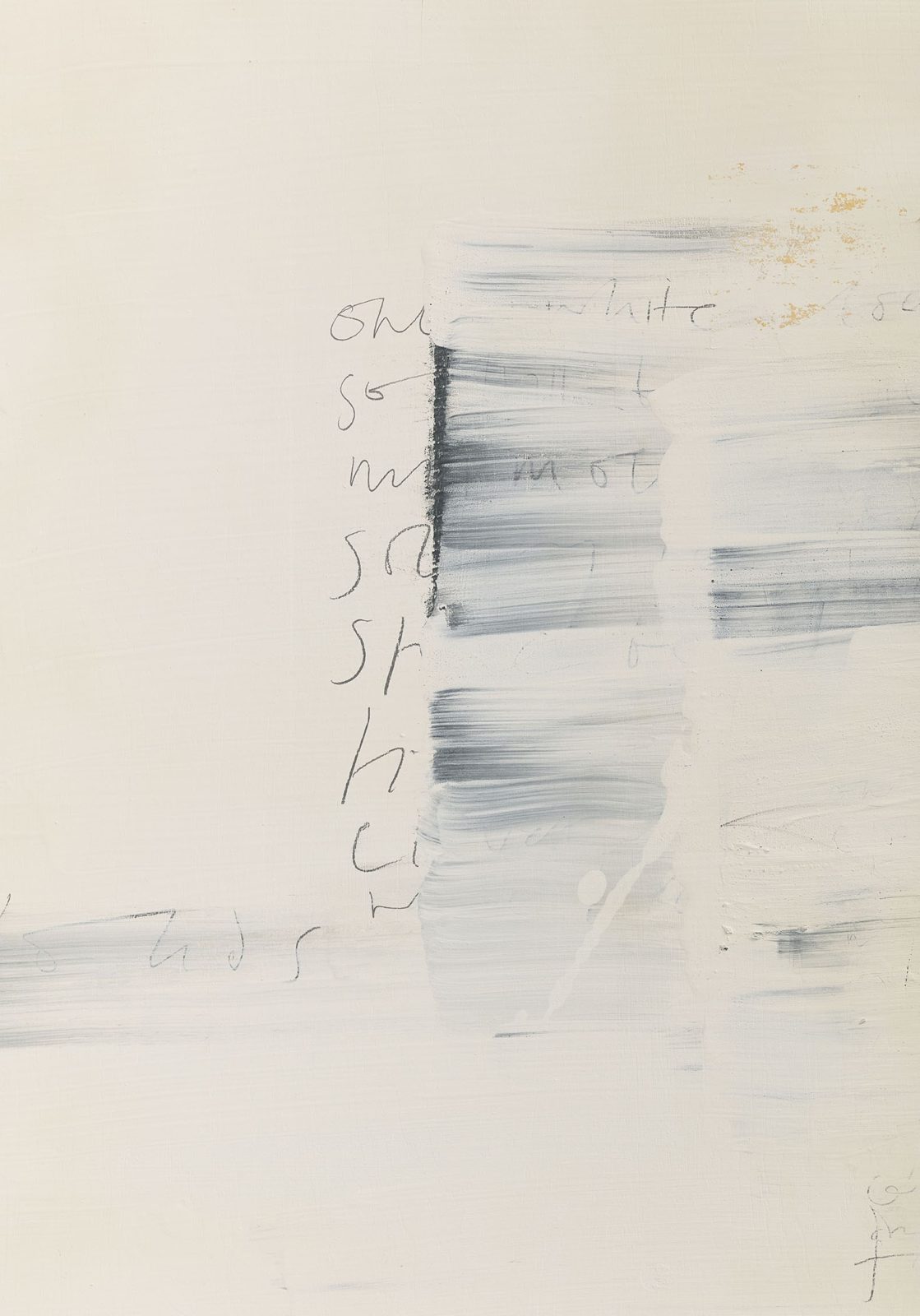
poems from cold mountain, II (detail)2020
Diptych of oak panels with liquid kaolin, gold leaf, graphite and compressed charcoal in an open aluminium frame. Gilded on reverse.
92 × 125 × 7.5 cm
cold mountain clay
Gagosian, Hong Kong
20 November 2020 – 9 January 2021
Solitude is exacting. I read [the verses] out, wrote them, effaced them, worked on them, trying to find the amount of white space around a poem so that the words emerge... These works are my way of writing on a cave wall.
—Edmund de Waal
This exhibition takes its title from the famed Cold Mountain poems, a series of verses by the monk Hanshan, who, according to legend, lived as a recluse on the titular Chinese mountaintop during the Tang Dynasty (618–907 CE). Inspired by Hanshan’s practice of writing on rocks, tree trunks, and cave walls—thereby letting the elements erode his verses—de Waal’s new works are made through a cycle of inscription and effacement. He begins by coating a wood panel in liquid kaolin; while the slip is still wet, he floats flecks of gold leaf and writes lines of Hanshan’s poetry in graphite, oil stick, and charcoal. He then brushes these marks with additional layers of kaolin slip, repeating the process multiple times to produce a “fugitive poem,” an ethereal palimpsest of text that emulates the haze of memory.
Photography: Stephen Head
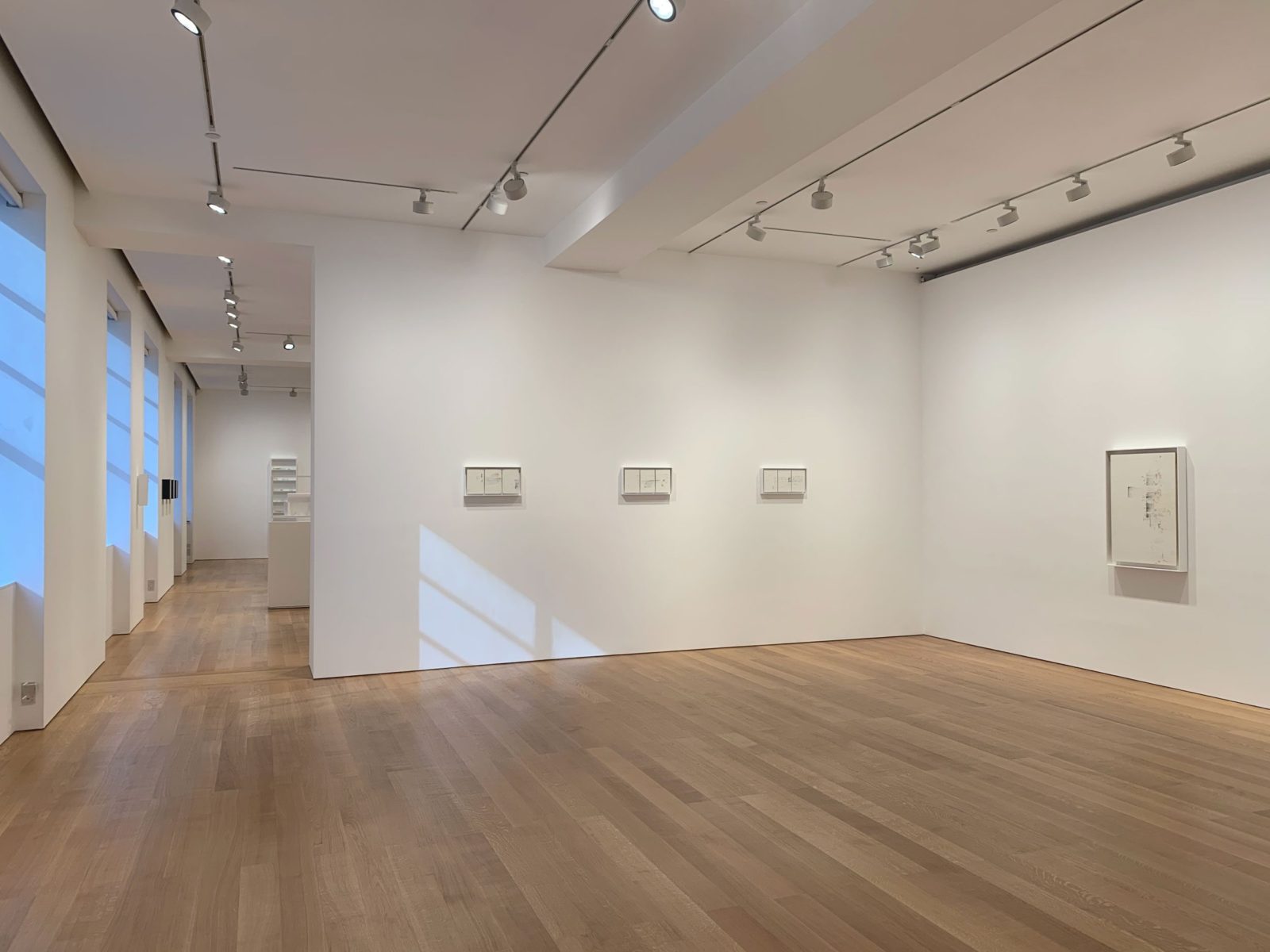
installation view2020
cold mountain clay
Gagosian, Hong Kong
20 November 2020 – 9 January 2021
Solitude is exacting. I read [the verses] out, wrote them, effaced them, worked on them, trying to find the amount of white space around a poem so that the words emerge... These works are my way of writing on a cave wall.
—Edmund de Waal
This exhibition takes its title from the famed Cold Mountain poems, a series of verses by the monk Hanshan, who, according to legend, lived as a recluse on the titular Chinese mountaintop during the Tang Dynasty (618–907 CE). Inspired by Hanshan’s practice of writing on rocks, tree trunks, and cave walls—thereby letting the elements erode his verses—de Waal’s new works are made through a cycle of inscription and effacement. He begins by coating a wood panel in liquid kaolin; while the slip is still wet, he floats flecks of gold leaf and writes lines of Hanshan’s poetry in graphite, oil stick, and charcoal. He then brushes these marks with additional layers of kaolin slip, repeating the process multiple times to produce a “fugitive poem,” an ethereal palimpsest of text that emulates the haze of memory.
Photography: Stephen Head
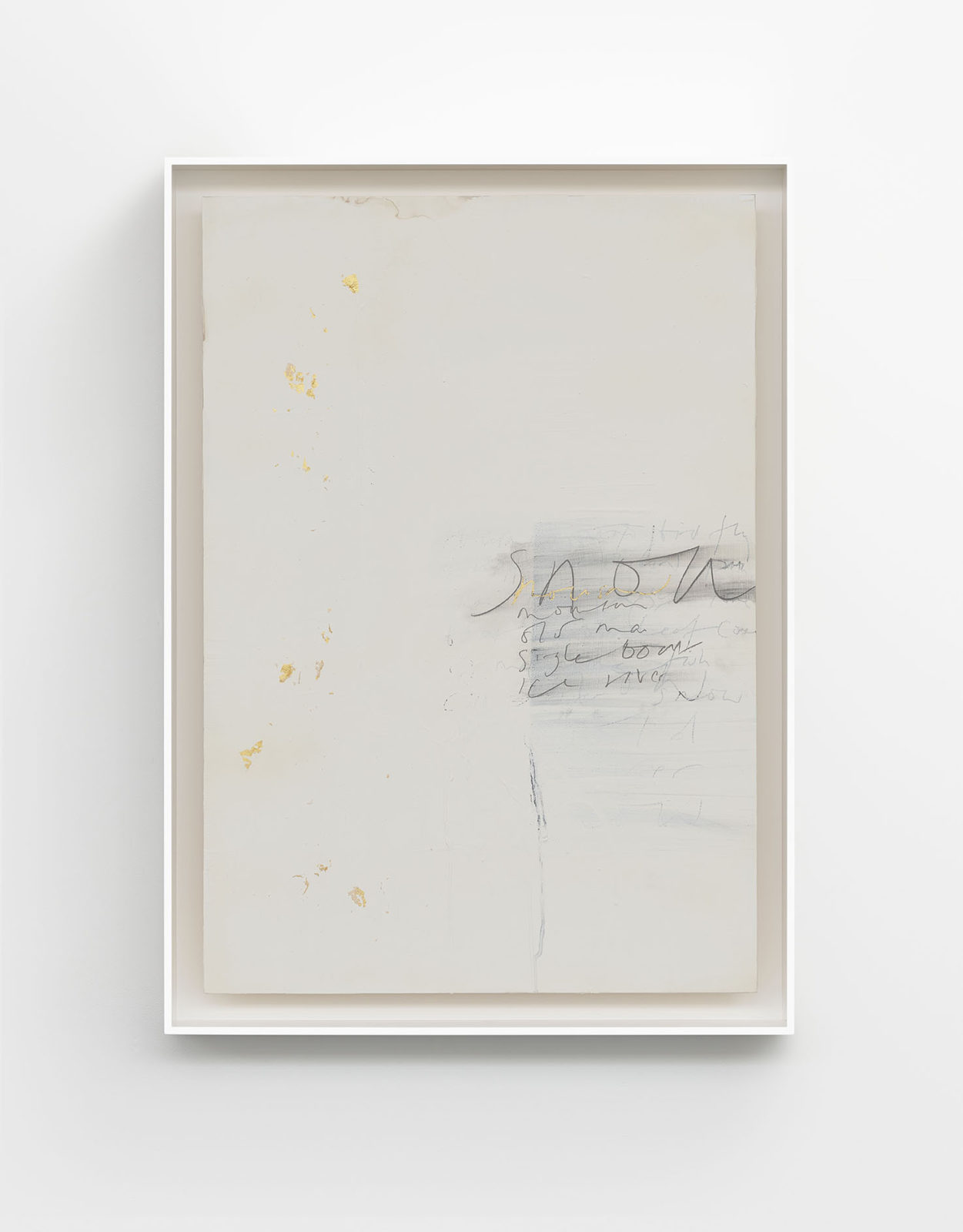
river snow2020
Ash panel with liquid kaolin, gold leaf, graphite and compressed charcoal in an open aluminium frame. Gilded on reverse.
92 × 66 × 7.5 cm
cold mountain clay
Gagosian, Hong Kong
20 November 2020 – 9 January 2021
Solitude is exacting. I read [the verses] out, wrote them, effaced them, worked on them, trying to find the amount of white space around a poem so that the words emerge... These works are my way of writing on a cave wall.
—Edmund de Waal
This exhibition takes its title from the famed Cold Mountain poems, a series of verses by the monk Hanshan, who, according to legend, lived as a recluse on the titular Chinese mountaintop during the Tang Dynasty (618–907 CE). Inspired by Hanshan’s practice of writing on rocks, tree trunks, and cave walls—thereby letting the elements erode his verses—de Waal’s new works are made through a cycle of inscription and effacement. He begins by coating a wood panel in liquid kaolin; while the slip is still wet, he floats flecks of gold leaf and writes lines of Hanshan’s poetry in graphite, oil stick, and charcoal. He then brushes these marks with additional layers of kaolin slip, repeating the process multiple times to produce a “fugitive poem,” an ethereal palimpsest of text that emulates the haze of memory.
Photography: Stephen Head
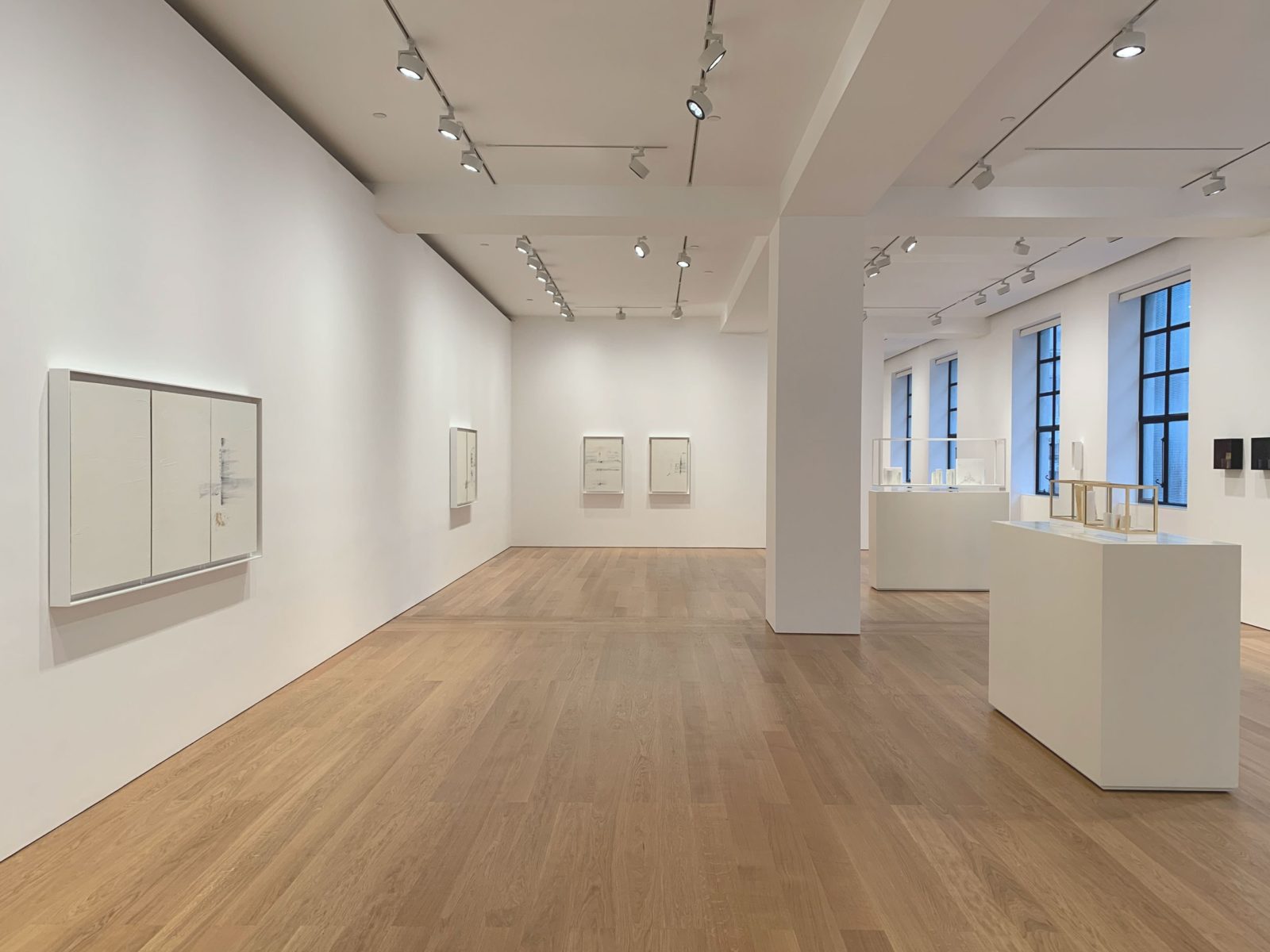
installation view2020
cold mountain clay
Gagosian, Hong Kong
20 November 2020 – 9 January 2021
Solitude is exacting. I read [the verses] out, wrote them, effaced them, worked on them, trying to find the amount of white space around a poem so that the words emerge... These works are my way of writing on a cave wall.
—Edmund de Waal
This exhibition takes its title from the famed Cold Mountain poems, a series of verses by the monk Hanshan, who, according to legend, lived as a recluse on the titular Chinese mountaintop during the Tang Dynasty (618–907 CE). Inspired by Hanshan’s practice of writing on rocks, tree trunks, and cave walls—thereby letting the elements erode his verses—de Waal’s new works are made through a cycle of inscription and effacement. He begins by coating a wood panel in liquid kaolin; while the slip is still wet, he floats flecks of gold leaf and writes lines of Hanshan’s poetry in graphite, oil stick, and charcoal. He then brushes these marks with additional layers of kaolin slip, repeating the process multiple times to produce a “fugitive poem,” an ethereal palimpsest of text that emulates the haze of memory.
Photography: Stephen Head
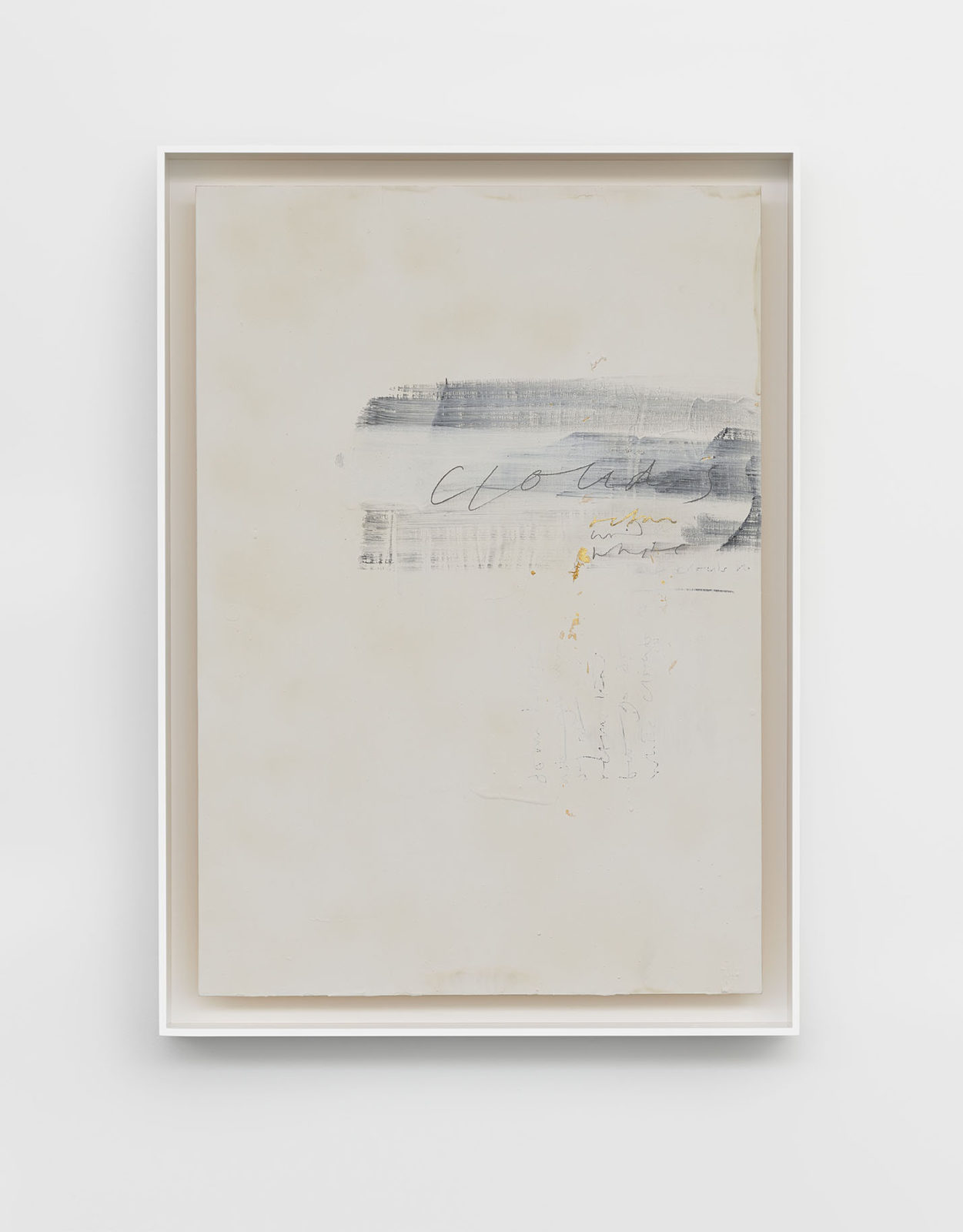
to see a friend off2020
Ash panel with liquid kaolin, gold leaf, graphite and compressed charcoal in an open aluminium frame. Gilded on reverse.
92 × 66 × 7.5 cm
cold mountain clay
Gagosian, Hong Kong
20 November 2020 – 9 January 2021
Solitude is exacting. I read [the verses] out, wrote them, effaced them, worked on them, trying to find the amount of white space around a poem so that the words emerge... These works are my way of writing on a cave wall.
—Edmund de Waal
This exhibition takes its title from the famed Cold Mountain poems, a series of verses by the monk Hanshan, who, according to legend, lived as a recluse on the titular Chinese mountaintop during the Tang Dynasty (618–907 CE). Inspired by Hanshan’s practice of writing on rocks, tree trunks, and cave walls—thereby letting the elements erode his verses—de Waal’s new works are made through a cycle of inscription and effacement. He begins by coating a wood panel in liquid kaolin; while the slip is still wet, he floats flecks of gold leaf and writes lines of Hanshan’s poetry in graphite, oil stick, and charcoal. He then brushes these marks with additional layers of kaolin slip, repeating the process multiple times to produce a “fugitive poem,” an ethereal palimpsest of text that emulates the haze of memory.
Photography: Stephen Head
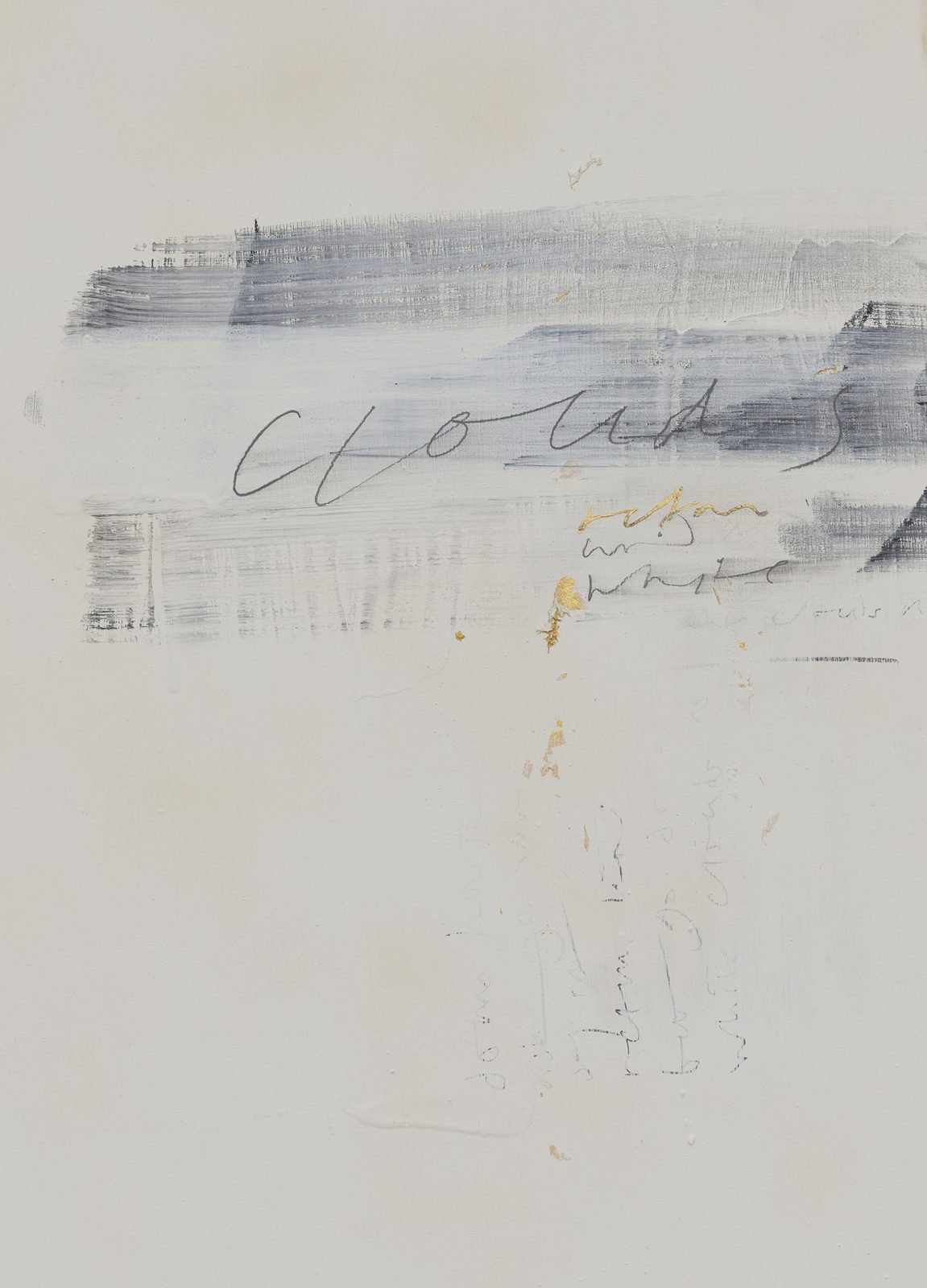
to see a friend off (detail)2020
Ash panel with liquid kaolin, gold leaf, graphite and compressed charcoal in an open aluminium frame. Gilded on reverse.
92 × 66 × 7.5 cm
cold mountain clay
Gagosian, Hong Kong
20 November 2020 – 9 January 2021
Solitude is exacting. I read [the verses] out, wrote them, effaced them, worked on them, trying to find the amount of white space around a poem so that the words emerge... These works are my way of writing on a cave wall.
—Edmund de Waal
This exhibition takes its title from the famed Cold Mountain poems, a series of verses by the monk Hanshan, who, according to legend, lived as a recluse on the titular Chinese mountaintop during the Tang Dynasty (618–907 CE). Inspired by Hanshan’s practice of writing on rocks, tree trunks, and cave walls—thereby letting the elements erode his verses—de Waal’s new works are made through a cycle of inscription and effacement. He begins by coating a wood panel in liquid kaolin; while the slip is still wet, he floats flecks of gold leaf and writes lines of Hanshan’s poetry in graphite, oil stick, and charcoal. He then brushes these marks with additional layers of kaolin slip, repeating the process multiple times to produce a “fugitive poem,” an ethereal palimpsest of text that emulates the haze of memory.
Photography: Stephen Head
